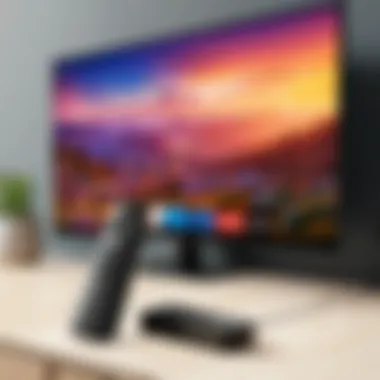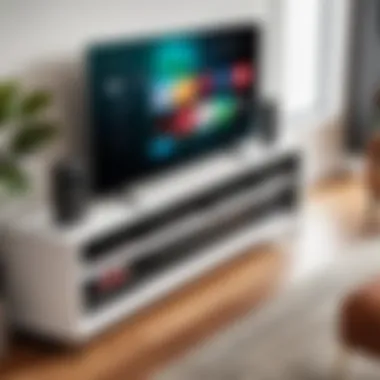Mastering the Hunt for Your Firestick Remote


Intro
In the modern age of streaming, the Amazon Firestick has risen as a pivotal device. It consolidates entertainment into a single platform, giving users access to various applications and services. However, this ease of use can sometimes become hindered by misplacing the remote, which often feels like an irritating ordeal. Finding your Firestick remote can quickly devolve into a frantic search, disrupting your relaxation time. This article aims to provide useful methods for locating your remote, enriching your user experience, and preventing future misplacements.
Overview of the Technology
The Amazon Firestick operates on a simple yet efficient principle. It acts as a bridge between your television and various streaming services such as Netflix, Hulu, and Amazon Prime Video. Its compact design makes it a versatile solution for many entertainment needs.
Key Specifications
- Processor: The latest models utilize a quad-core CPU ensuring smooth streaming
- Resolution: Support for both HD and 4K UHD formats
- Storage: Integrated storage allows downloading of apps without hindrance
Unique Selling Points
The Firestick stands out due to its:
- User-Friendly Interface: Simple navigation for users of all skill levels
- Voice Control: Integration with Alexa enhances usability
- Affordability: Competes well on price without compromising features
Design and Build Quality
The design of the Firestick remote warrants attention. Its size and shape are intended for comfort, making it easy to hold and operate.
Material Used
Made with durable plastic, the remote is designed to endure everyday use. Its lightweight composition aids in handling during extended viewing periods.
Ergonomics and Usability
The arrangement of buttons on the remote ensures easy access to key functions, such as volume control and playback. The placement helps to operate it without much thought, allowing you to focus on the content.
As tech-savvy individuals, it is paramount to understand these features. Familiarity with the Firestick's capabilities aids in maximizing the benefits it provides. Now, let’s explore the common challenges we face when trying to locate the remote and the strategies to overcome them.
Understanding the Amazon Firestick
The Amazon Firestick represents a significant advancement in home entertainment technology. Understanding this device is fundamental for any user who aims to maximize its features, leading to a richer viewing experience. The Firestick not only simplifies access to a variety of streaming services but also enhances overall media consumption. Therefore, grasping its function and attributes demystifies the usage of the remote and establishes a smoother interaction between user and technology.
Overview of Amazon Firestick
The Amazon Firestick is a compact device that connects to your television's HDMI port, effectively transforming standard TVs into smart TVs. It offers access to popular streaming platforms like Netflix, Hulu, and Amazon Prime Video, providing users with a treasure trove of content. One of its strengths is the ability to support various resolutions; from 720p to 4K, depending on the model.
Moreover, the Firestick integrates user-friendly features like voice search capability via Alexa. This means users can simply speak commands instead of navigating through menus. It also supports apps and games, thus augmenting its utility beyond just streaming, making it a versatile entertainment hub.
Common Features of the Remote Control
The remote control for the Amazon Firestick is designed for efficiency and ease of use. One of its most notable features is the voice control button, allowing users to utilize voice commands to find content or control their viewing experience. This feature can significantly reduce the frustration often found with traditional remote controls.
In addition, the remote includes navigation buttons that are intuitive, enabling quick access to your favorite channels or programs. Another critical aspect is the dedicated buttons for popular streaming services, providing immediate access to platforms without needing to scroll through menus.
Battery life is an important consideration as well; the remote typically uses two AAA batteries, which can last several months depending on usage. Therefore, understanding these features helps to appreciate the full scope of what the Firestick and its remote are capable of, setting the stage for discussions on misplacement and how to find the remote when it goes missing.
The Importance of the Remote


The remote control for the Amazon Firestick stands as a fundamental tool in navigating the breadth of digital content available today. Its relevance extends beyond mere functionality; it enhances the overall user experience. The remote is not just a device; it serves as a bridge between the user and a vast array of entertainment options, from streaming services to app functionalities. Understanding its importance can significantly optimize one’s engagement with technology.
Why the Remote is Crucial for Navigation
Navigating through the Amazon Firestick system is highly dependent on the efficiency of the remote control. The remote provides quick access to features such as voice search, channel switching, and multimedia controls. Without it, the experience becomes cumbersome. Users may find themselves struggling to operate the device effectively, leading to frustration. The fluid interaction facilitated by the remote enables a seamless exploration of content, which is vital for maintaining an engaging viewing experience.
For instance, the inclusion of dedicated buttons for popular apps like Netflix or YouTube allows users to switch effortlessly between various entertainment options. Moreover, the advanced voice control capabilities can significantly enhance accessibility, offering a hands-free experience while searching for shows or navigating menus. Thus, the remote's design is tailored to enrich the overall interaction with the Firestick.
Impact of Remote Absence on User Experience
The absence of the remote transforms a convenient device into a complicated gadget. If one misplaces the remote, the experience can quickly shift from enjoyable to exasperating. Users face limitations imposed by the unavailability of quick access functions. This situation not only disrupts viewing habits but can also deter users from making the most of the Firestick’s capabilities.
"Without the remote, users may unintentionally miss out on many features that make the Firestick a versatile entertainment system."
Some efficient commands become almost impossible to achieve manually, diminishing the effectiveness of the device. Users may resort to alternatives, such as the mobile app, but these often do not replicate the same convenience, adding further layers of complexity to an otherwise straightforward interaction.
Overall, understanding the crucial role of the remote in enhancing navigation and user experience can guide users in establishing better habits around their device management. Recognizing its centrality can lead to strategies that help prevent misplacement in the first place, fostering a more satisfying and effective entertainment experience.
Accidental Misplacement of the Remote
In the context of technology, the misplacement of gadgets often leads to frustration. The Amazon Firestick remote is no exception. Acknowledging how often users misplace their remotes can help address the issue effectively. This segment delves into the various aspects of accidental misplacement, emphasizing its significance in this guide. Understanding the common areas where remotes go missing, along with typical behavior patterns that lead to their misplacement, creates a better foundation for practical strategies that follow later.
Common Areas Where Remotes are Misplaced
When looking for the Firestick remote, it can be helpful to focus on specific areas that are notorious for holding lost items. Below are some frequently overlooked places:
- Cushions of the Sofa: The remote frequently slips between couch cushions. It is advisable to check thoroughly in this area.
- Under Furniture: Items can drift under coffee tables, entertainment centers, and other low furniture.
- Bedside Tables: The remote might end up on the bedside table or even under the bed after a relaxed night of streaming.
- Kitchen Counters: Sometimes it is placed there during meal preparations or snack breaks.
- Bathroom Areas: In a moment of distraction, individuals might carry the remote to the bathroom.
Knowing these places helps to narrow the search, optimizing the time spent looking for the remote.
Typical Behavior Patterns Leading to Misplacement
User behavior plays a crucial role in the misplacement of the Firestick remote. Below are some behaviors commonly associated with losing track of the remote:
- Multitasking: Users often switch between various activities or devices, causing them to forget where they placed the remote.
- Changing Locations: Moving the remote from one room to another without a designated spot frequently results in misplacement.
- Inattentiveness: Being distracted by a movie or series can lead to leaving the remote in unexpected places.
- Collective Usage: When multiple people use the remote, the likelihood of someone misplacing it increases significantly.
Understanding these behavior patterns is critical. By modifying how one interacts with the remote, it is possible to reduce the chances of losing it in the first place.
Practical Strategies for Finding the Remote
The significance of employing practical strategies to locate the Firestick remote cannot be understated. As users invest in a streaming device for seamless entertainment, the remote control becomes an essential tool for navigation. Effective strategies not only save time but also reduce frustration associated with misplacement. Furthermore, these approaches can enhance overall user experience by allowing for quick access to desired content.
Using Visual Checks in Likely Locations
A quick visual check in locations where the remote often resides is a straightforward yet effective initial strategy. Regularly scanning familiar surfaces such as coffee tables, couches, and shelves can yield quick results. Since remotes tend to blend in with various household items, it’s important to look carefully. Pay attention to spots where you frequently lounge or where the remote likely encountered a resting place.
Consider using bright lighting or even your smartphone’s flashlight feature to illuminate dark areas. This method encourages a thorough inspection that can often reveal a mislaid remote in seconds.
Implementing a Systematic Search Method
A systematic search method involves a methodical approach to tracking down the lost remote. This strategy increases the likelihood of finding the remote while minimizing repeated searches in the same places. Two effective aspects of this method include prioritizing each room individually and focusing on common hiding spots.


Prioritize Room by Room
Focusing on one room at a time allows for a more organized search. By not attempting to check multiple rooms at once, you can maintain focus. This characteristic of concentrating your efforts in a single area promotes an efficient search pattern. Each room often has a set of predictable places where the remote could be found, which aids in recalling locations you might have overlooked.
Breaking the process down room by room ensures no potential hiding spots are neglected. Although it may take longer to scan each room, this thoroughness often leads to success with less stress.
Focus on Common Hiding Spots
Common hiding spots are areas that frequently serve as resting places for the remote. These include beneath cushions, inside drawers, or even behind the television set. The advantage of focusing on these typical areas lies in their tendency to capture the remote during everyday use.
This method takes into account the usual behavior patterns of users. Knowing where you often place the remote encourages faster recovery. Additionally, it invites the possibility of spotting it in places you might not have expected. However, an overemphasis on conventional hiding spots could lead to overlooking less probable locations if not combined with other methods.
By integrating visual checks and systematic searches, users can significantly enhance their chances of locating the Firestick remote and consequently enjoy a smoother entertainment experience.
Technical Solutions to Locate the Remote
In the modern world of tech-centric living, finding a misplaced remote can be a frustrating challenge. This section focuses on technical solutions to locate the Amazon Firestick remote, emphasizing their importance in enhancing user experience and reducing stress associated with misplacement. By exploring advanced tracking mechanisms and mobile technology, readers can save time and maintain seamless access to their entertainment.
Using Third-Party Tracking Devices
Overview of Tracking Technology
Tracking technology has evolved significantly, making it simpler to find misplaced devices such as remotes. Devices like Tile and similar products use a combination of Bluetooth connectivity and user-friendly apps to help locate items within a set range. The key characteristic of tracking technology is its ability to provide real-time location updates within a defined proximity. For individuals frequently misplacing their remotes, this offers a notable benefit, minimizing search time and enhancing convenience.
The unique feature of a tracking device lies in its proactive alert system. If a user moves out of range, the app will notify them, ensuring that their remote does not go missing unnoticed. However, some may find dependency on battery life a disadvantage, as it necessitates regular charging or replacement to ensure consistent performance in locating the remote.
Choosing the Right Device
When it comes to choosing the right tracking device, compatibility and functionality are paramount. Many tracking devices are designed to work with various gadgets, not limited to remotes alone. The main characteristic to consider is the range of connectivity; some devices operate effectively up to 150 feet, while others boast a wider range. This feature is crucial for tech-savvy users who need flexibility in usage.
A significant advantage of devices like Tile is their extensive community feature. Users can report a lost item, leveraging the network of other users to aid in recovery—this makes it a popular choice for those often on the go. However, a potential downside is that subscription models may incur ongoing costs, which is essential to weigh against the convenience they offer.
Exploring Smartphone Apps for Remote Search
Smartphone apps provide another layer of convenience for locating a missing Firestick remote. These applications leverage the smartphone's existing capabilities, negating the need for an additional device. Many apps are compatible with popular operating systems like iOS and Android, we are making them accessible to a broad audience.
Most applications rely on Bluetooth technology, creating a direct link to the remote. Users can simply open the app and track their remote's last known location on a map. This is particularly advantageous for individuals who already have smartphones, eliminating the need for further investment in tracking devices.
Preventing Future Remote Misplacement
Preventing future remote misplacement is a vital topic in maintaining an enjoyable and seamless entertainment experience with the Amazon Firestick. Having outlined various strategies for locating a lost remote, it’s essential to shift the focus toward proactive measures. This section emphasizes the significance of establishing habits and environments that minimizes the chances of losing the remote in the first place.
By creating structured routines and designated spaces for your devices, you can save time and reduce frustration. Ensuring that the remote has a specific location will help cultivate a system of organization that benefits all tech users. These strategies not only enhance user experience but also foster a better relationship with your devices.
Creating a Designated Spot for the Remote
One of the simplest yet most effective ways to prevent misplacement is to establish a designated spot for your Firestick remote. This could be a small tray on your coffee table, a shelf in your entertainment unit, or a specific drawer. The key is to choose a location that is easily accessible and consistently used.
Having a single location for the remote not only reduces the time spent searching but also reinforces a habit of putting it back in the same place after use. When family members or roommates are aware of the designated spot, it promotes accountability. Here are some practical tips for implementing this strategy:
- Choose a location that is both visible and convenient.
- Keep the area organized and free from clutter to avoid losing the remote again.
- Encourage all users in your home to return the remote to the designated spot after each use.


Incorporating Remote Control Holders
Integrating a remote control holder into your living space is another practical solution to prevent misplacing your Firestick remote. These holders come in various designs and can be placed on furniture such as tables, shelves, or even mounted on walls. By having a specific holder, the remote becomes a permanent fixture in your environment.
Here are some benefits of using remote control holders:
- Visibility: Keeping the remote in a holder makes it less likely to get buried among other items, improving the chances of quickly locating it.
- Convenience: Holders come in various styles that complement your decor while providing easy access when needed.
- Organization: A dedicated holder can reduce clutter, making the living area more organized.
In summary, both creating a designated spot and incorporating remote control holders are proactive measures that can significantly decrease the frequency of misplacing your Firestick remote. By being intentional about where you keep your remote, you set a foundation for a more enjoyable overall experience with your device.
"A little organization can go a long way; with a few simple habits, you can transform your remote usage experience."
Alternatives to the Standard Remote
In the digital age, reliance on conventional remote controls can be cumbersome and limiting. Knowing the alternative methods available not only enhances the user experience but also mitigates the stress that comes with lost remotes. Alternatives to the standard Firestick remote bring both convenience and versatility that can cater to different user preferences and lifestyles. Furthermore, these alternatives often integrate seamlessly into existing technology ecosystems, providing an efficient solution to remote management.
Using the Fire TV Mobile App as a Remote
The Fire TV mobile app presents a notable alternative for users who frequently misplace their remotes. Available for both Android and iOS operating systems, the app transforms your smartphone into a fully functional remote control. This eliminates the need to scavenge for a physical device when you want to change channels or adjust settings.
Key Benefits of the Fire TV Mobile App:
- Touchscreen Interface: The app features a user-friendly touchscreen interface which can make navigation more intuitive than traditional buttons.
- Keyboard Functionality: Users can type in search queries effortlessly using their phone’s keyboard, enhancing search speed and accuracy.
- Voice Input: The app supports voice commands through your smartphone, allowing for easy navigation and control.
Developing a habit of using the app could effectively decrease dependence on the physical remote, potentially reducing the instances of it being lost. Additionally, the app allows for control of compatible smart home devices, creating an integrated solution for managing your entertainment and smart technology from a single device.
Exploring Voice Control Options
Voice control systems, such as Amazon’s Alexa, have changed how users interact with technology. This option can be particularly beneficial for Firestick users who may find physical remotes inconvenient or outdated. Voice control adds a level of ease, allowing users to navigate services hands-free and engage with content through simple commands.
Advantages of Voice Control:
- Convenience: Users can simply speak commands, which is faster and more intuitive than manual navigation.
- Accessibility: Voice control makes it easier for individuals with mobility challenges to access and manage their Firestick experience.
- Smart Integration: Alexa can also control various smart home devices, offering a cohesive technology management system in your home.
Utilizing voice control not only provides a practical solution for losing physical remotes but also enhances the overall entertainment experience. Commands like "Play [title] on Firestick" or "Pause the video" can streamline interactions with your content.
Ultimately, understanding and embracing these alternatives can greatly improve the ease with which you interact with your Fire TV and minimize frustrations associated with remote misplacement.
Final Thoughts on Remote Usage
The discussions around remote control usage often revolve primarily around convenience and efficiency. However, the insights gained throughout this article suggest a more nuanced perspective. The Amazon Firestick remote is not just a tool; it represents the intersection of technology and user experience. Understanding how to locate and optimize this device allows for a more seamless entertainment experience.
Evaluating the Need for Remote Replacement
Determining whether the Amazon Firestick remote needs replacement can be challenging. The decision should take into consideration various factors that may impact user satisfaction. First, assess the current functionality of the remote. If it has missing buttons, erratic performance, or connectivity issues, these might signal a need for change.
- Age and Wear: If the device is older and has seen better days, it might be wise to invest in a new one.
- Upgrade Options: Amazon frequently updates its devices. Evaluating newer models may offer additional features that enhance your experience.
- Compatibility with Other Devices: Consider if the new remote is necessary for enhanced compatibility with updated devices or systems you may be using in your smart home setup.
Ultimately, being proactive in evaluating your remote will lead to better technology experiences.
Adapting to New Technologies in Remote Control
As technology advances, so do the functionalities associated with remote controls. Users should be aware of the capabilities that newer technologies may offer. Many people often overlook the potential of smartphone applications that serve as remote controls. These apps can bring additional features, such as:
- Voice Commands: Use voice to navigate content without manual input.
- Integrated Services: Access various streaming services without flipping between remotes or devices.
- Updates and Support: Apps are easier to update compared to physical remotes, ensuring users have the latest features.
Moreover, embracing voice control options and universal remotes can significantly enhance the user experience. Incorporating new technology allows the user not only to keep pace with advancements but also to enjoy increased functionality and convenience.
New technologies provide users with alternatives that can enrich their entertainment experience beyond traditional remotes.







